Michael Vick, Bryan Randall, Marcus Vick, Tyrod Taylor, Logan Thomas. Virginia Tech has had a string of mobile quarterbacks over the past decade and a half. Michael Vick burst onto the scene back in '99, and transformed the way that college football utilized mobile quarterbacks forever. Scot Loeffler in his own words describing his offense (emphasis mine), "...it's really a pro-style offense, that's multiple, with the ability to run the quarterback, and I think you got to do some of that in college football now." Programs like West Virginia, Florida, Nevada, and Oregon have revolutionized the way that offenses highlight the strengths of their dual-threat signal callers. The success of these programs prove that mobile quarterbacks aren't a trend, they aren't a fad, and they aren't going anywhere. I can say this with certainty because football is, at its heart, a numbers game.
Change the Math
Involving the QB in the run game "changes the math" in favor of the offense more than any other tactic in football. Both the offense and defense get 11 players on the field. On a normal run play, with a QB that isn't a threat to run the ball, the QB hands the ball off to the running back and the other nine players on the offense block for him. That means the defense will have two unblocked defenders for any traditional running play. Let's take a look at a hand-off out of the shotgun formation.
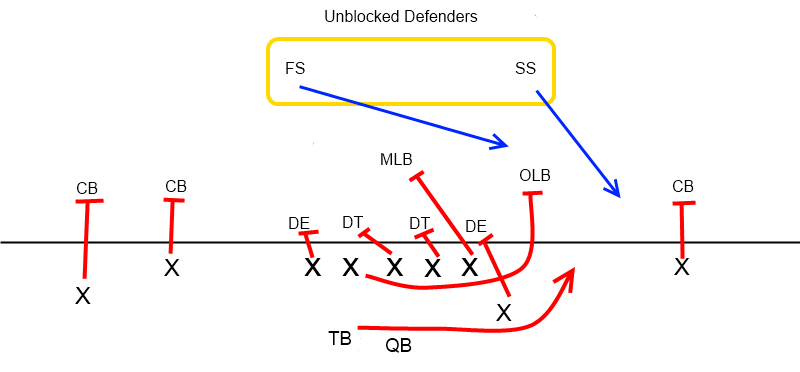
The offense doesn't have anyone to block the strong or the free safety. In order to break free for a touchdown, the offense will have to execute all of its blocks AND the tailback will have to make two defenders miss. Without a strong passing game the situation gets even more unfavorable, since the safeties will be able to creep closer and closer to the line to attack the handoff.
I don't have much love for anything Mountaineer, but Rich Rodriguez is considered a pioneer of the run-first shotgun spread, largely because he’s credited with inventing the zone-read play. Anyone who’s watched college football for the past decade knows the zone-read by now. Out of the shotgun, the QB "reads" an unblocked defensive end. If the DE attempts to tackle the QB, the QB will hand the ball off to the RB, who runs behind his zone-blocking offensive line (hence the name “zone-read”). If the DE runs to tackle the RB, the QB keeps the ball and runs the opposite direction of the RB. Thanks to Rich Rod, offenses which wanted to operate out of the shotgun could have the same numbers advantage in their rushing attack that triple-option teams had.
The QB Power
Teams across the country started basing their entire offense around a shotgun read-option package. Coaches started getting creative and began tinkering with the zone-read to better fit the skill set of their athletic QBs. Urban Meyer in particular had a ton of success by focusing on a QB power running system when he had Tim Tebow. Loeffler spent some time at Florida, coaching Tim Tebow during his senior season. During Tebow's senior year, he led the country in passing efficiency. How was a player with such a maligned throwing motion able to accomplish this? Urban Meyer forced defenses to put an extra defender in the box, giving Tebow more one-on-one matchups and easier throws.
Above we saw the advantage that defenses have when the QB isn't a factor in the running game. Let's take a look at a staple of Urban Meyer's QB rushing attack, the inverted veer.
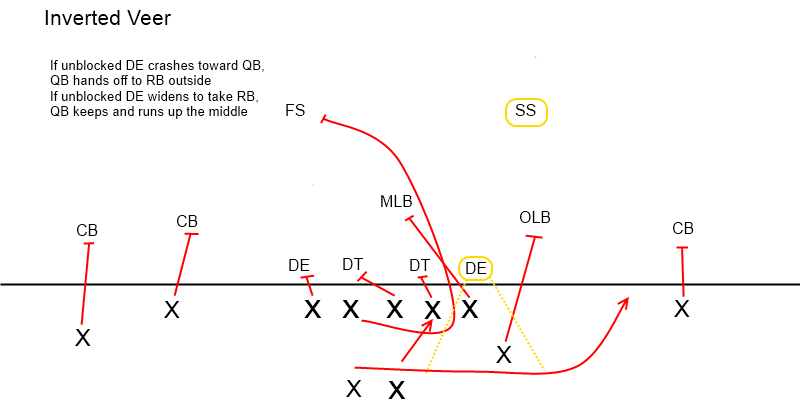
This play is based off of the triple-option offense "veer", where the QB reads the unblocked DE. In this version of the play, the DE is still unblocked. The QB reads him, if he crashes hard at the QB he hands off to the RB. If the DE hesitates or attacks the RB, the QB keeps it and runs into the hole following his blockers. Theoretically the DE will never be able to make the tackle, which means the offense has "blocked' him with the QB's decision making. The only player left to make a tackle is the strong safety, giving the offense much better odds at hitting a big play. Here is the inverted veer in action.
When executed correctly, it's a devastating play. Urban Meyer has had a ton of success with this play in his career, and he continues to shred defenses with it at OSU.
Loeffler and the Inverted Veer
Watching the games from Loeffler's time as offensive coordinator at Temple and Auburn, it's obvious that he picked up some valuable lessons while at Florida. Loeffler is without a doubt a "pro-style" offensive coordinator. He isn't a spread guru, he won't be operating out of the shotgun 90% of the time, and he won't be consistently putting his QB in harm's way while running the ball. However, Loeffler does recognize that there are benefits to incorporating elements of Urban Meyer's spread rushing attack into his offense. Forcing the defense to account for the quarterback in the run game increases the effectiveness of your offense, which is why Loeffler attempted to do just that while at Temple and Auburn.
Loeffler clearly prefers to use the inverted veer when using his QB as a runner. The formation that he runs this play out of most often is the shotgun, with an H-Back on the opposite side of the formation as his RB. This is the same formation that we saw in the Tebow run earlier, and here it is at Auburn. Keep an eye on the defensive end that goes unblocked.
0:48–0:58
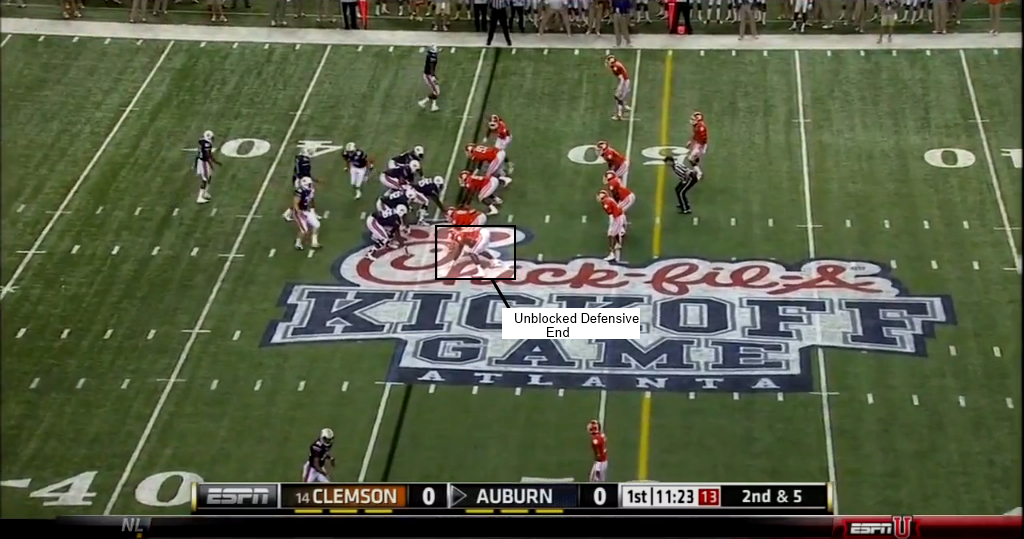
So... let's not focus on the play's outcome. That was pretty bad. Let’s pay attention to whether or not the principle behind the play was a good one. When we break it down, it's clear that this should have been a successful play. Frazier should be ready to give the ball to the RB unless the DE takes the RB. The unblocked DE clearly makes no move towards the RB but Frazier pulls the ball and runs with it anyway. He runs straight into his read’s waiting arms. Unfortunately for Auburn, it appears that a handoff would have resulted in a decent gain, as the blocks are there on the edge for the RB. If Frazier hands the ball off, the pursuit has no chance to make the tackle and the defense will have to rely on a defender defeating a block to prevent a long gain. Logan Thomas will need to make this read correctly for Loeffler's QB running game to have an impact.
The Scraping Linebacker
Defensive coordinators get paid too, and they have figured out some ways to battle spread-read tactics. One way that teams have defended Rich Rod's zone-read is to have the DE crash on the tailback while the linebacker scrapes to take the QB. The inverted veer and the zone-read are two separate plays (on the zone-read the QB attacks the backside, while he attacks the playside on the “Inverted veer”) but defenses have been able to use the "Scrape-Exchange" against both concepts.
At the first sign of an outside handoff to a RB, the defender with outside contain responsibilities will disregard any threat of a QB run. He will immediately try and get the angle on the RB by running towards the sideline. His aggressiveness should make it very difficult for the RB to beat him with a move, as the RB will still be going laterally when they meet. On a play-action pass, this defender also the responsibility of covering the RB. Meanwhile, when the DE goes unblocked after the snap he has to take the QB. The DE can't react to the fake hand-off at all, he has to stay at home and make the tackle on the QB if the QB makes the wrong read. If the contain defender scrapes hard and the DE takes the QB, the inverted veer will struggle.
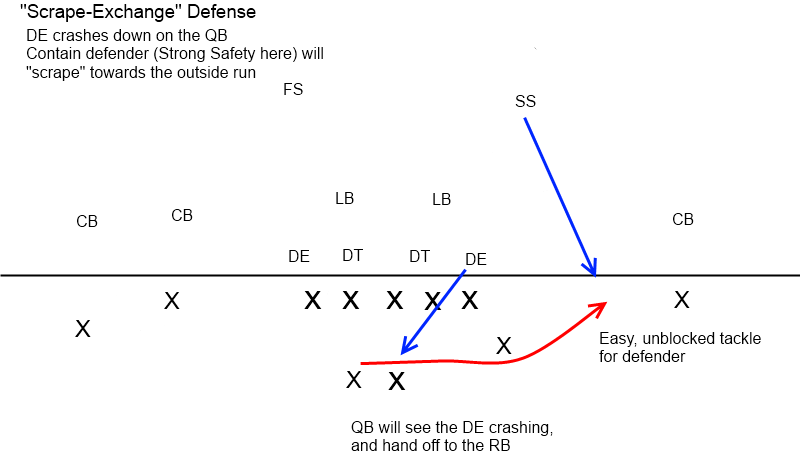
So what will Loeffler's response be when he sees defenses trying this tactic? The answer is simple but effective... block the defensive end!
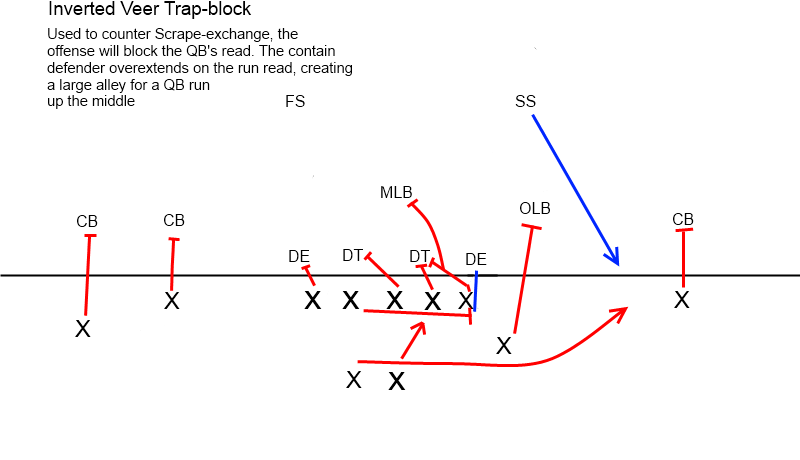
Once Loeffler sees that the contain man is really widening out to defend the outside run, he'll use one of his pulling guards to trap block the crashing defensive end. The contain man is "blocked" by his RB responsibilities, and that leaves the QB one on one with a safety again. This is still a read by the QB, but he’s using the RB as a safety valve more than anything else. Here, the QB will keep almost always. Only if the DE is off the line fast enough to threaten an immediate tackle for loss should the QB hand the ball off. Loeffler learned this wrinkle from Urban Meyer, who continues to have great success with it.
0:41–0:55
This is a perfect example of the trap block demolishing the defenses plans to stop the rush. Highlighted are the three main ingredients to a successful "Inverted Veer Trap-Block" play.
- LB leaving the box because of his outside RB run responsibilities
- DE plays QB, but gets trapped blocked
- The unblocked safety can't make the play versus the superior athlete

The contain defender get stretched out by the run fake, the defensive end gets trapped, and Braxton Miller makes the unblocked safety look foolish. Logan Thomas should have plenty of one-on-one "bull in the ring" sessions with opposing safeties this season. I like his odds.
A match made in heaven
I really, really, really like the prospect of watching Logan Thomas truck it through the middle of defenses this upcoming season. A major gripe I had with the direction the offense went last year was the misuse of Thomas's feet. Early in the season Thomas was asked too often to run outside of the tackle box, mostly because of the pistol. Since the RB is located directly behind the QB, any option or read from the pistol will require the QB to run to the outside. Thomas has good wheels, but he's not the shifty type of runner that will have frequent success heading towards the sideline. He's at his best when he's running behind his pads, full steam ahead, coming right at you.
Here he is on the edge, looking pretty pedestrian.
6:34–6:40
And here he two plays later, going yard on an inverted veer look.
6:40–7:03
The inverted veer pays dividends even when the offense isn't running it. We see here that simply having a similar mesh point between QB and RB freezes the MLB just long enough that he can't make the play on the sweep.
6:13–6:21
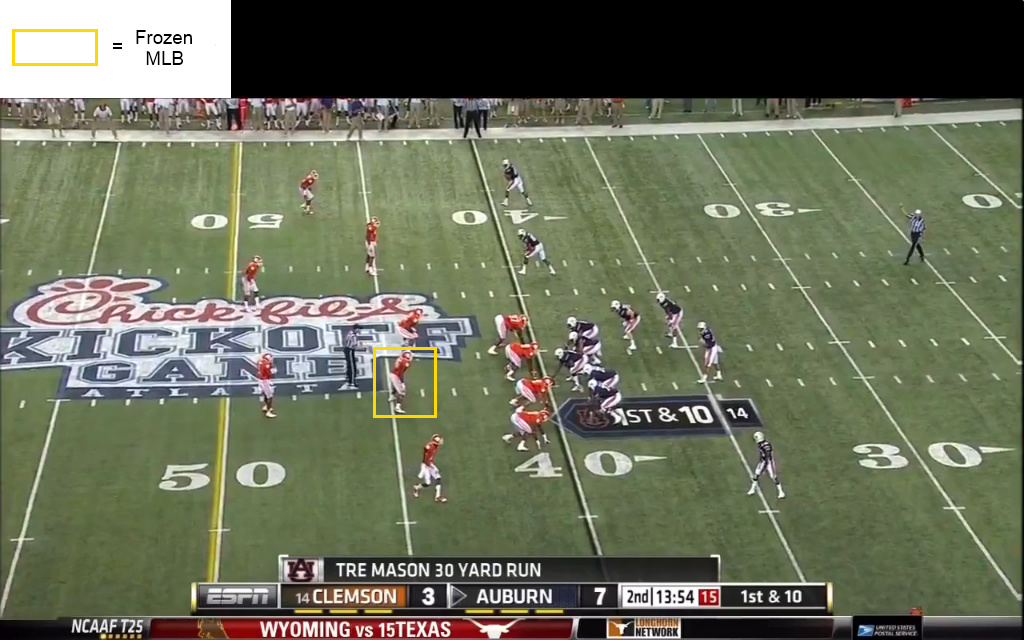
This is another example of "changing the math" by the veer. The offense can't account for the MLB if he reacts quick enough, but because he has to respect the QB run up the middle, he gets "blocked" out of the play.
Maybe the best thing about the Inverted Veer is how versatile it is. You can run it out of any shotgun formation and use any playmaker you want, doesn't need to be a RB. We see here that Loeffler brings a WR across the formation and has two lead blockers for the handoff. The DE goes unblocked and doesn't attack the WR's run, allowing Frazier to hand the ball off. Also, the MLB recognizes that the QB may pull the ball and run and hesitates for just a beat. The pause costs him the angle needed to tackle the WR.
10:28–10:34
I would love to see this play at Tech. Imagining Knowles getting a hand off and Edmunds lead blocking for him gets the juices flowing.
Heck, this play is so versatile you can run it with an empty backfield! Here's recent commit Andrew Ford running a variation of the "Inverted Veer Trap-Block". There's NO WAY we won't see this play at some point this year. We've already seen J.C. Coleman featured as a RB spread out wide in an empty backfield set, wouldn't take much coaching to having him come across the formation for the mesh.
0:59–1:09
Lastly, the play-action pass is deadly off an Inverted Veer look. Here's Urban Meyer up to his old tricks. This fake Inverted Veer prevents the safety from dropping deep in coverage, and the resultant single coverage leads to a spectacular catch versus single coverage.
8:36–8:43
Here's some great foreshadowing of things to come this season though. Logan Thomas shows an Inverted Veer handoff, only to pull the ball out and throw over the top to a teammate where an opposing safety should be.
1:49–1:56

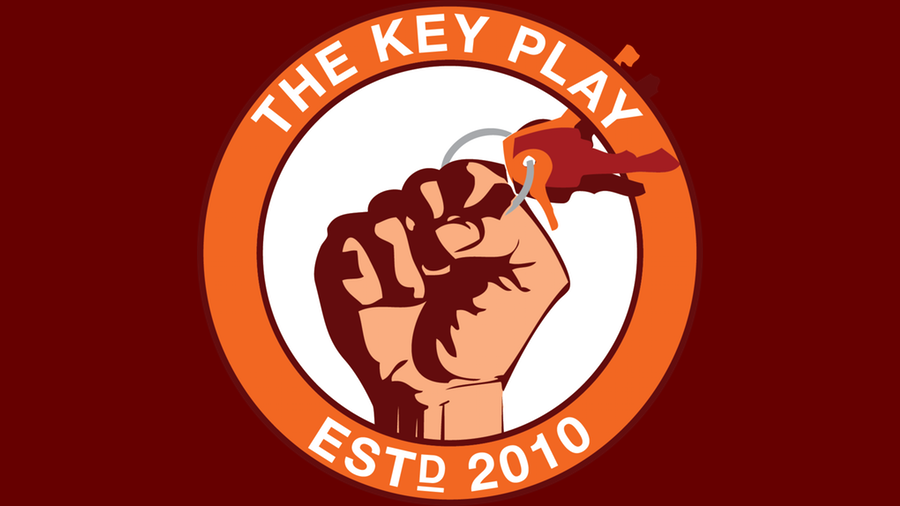
Comments
Please join The Key Players Club to read or post comments.
Please join The Key Players Club to read or post comments.
Please join The Key Players Club to read or post comments.
Please join The Key Players Club to read or post comments.
Please join The Key Players Club to read or post comments.
Please join The Key Players Club to read or post comments.
Please join The Key Players Club to read or post comments.
Please join The Key Players Club to read or post comments.
Please join The Key Players Club to read or post comments.
Please join The Key Players Club to read or post comments.
Please join The Key Players Club to read or post comments.
Please join The Key Players Club to read or post comments.
Please join The Key Players Club to read or post comments.
Please join The Key Players Club to read or post comments.
Please join The Key Players Club to read or post comments.
Please join The Key Players Club to read or post comments.
Please join The Key Players Club to read or post comments.
Please join The Key Players Club to read or post comments.
Please join The Key Players Club to read or post comments.
Please join The Key Players Club to read or post comments.